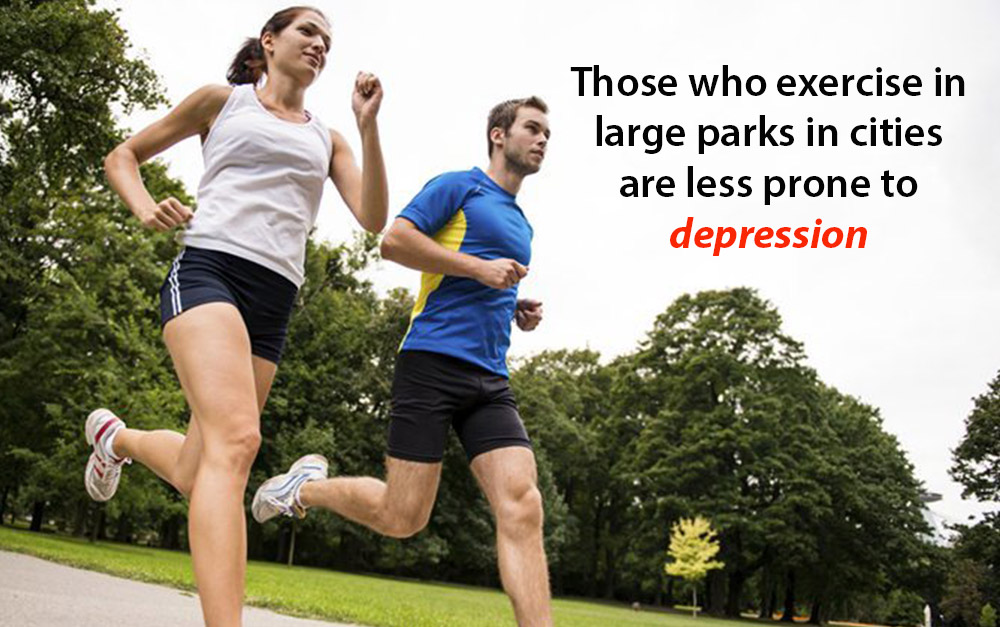Those who exercise in large parks in cities are less prone to depression
Availability of large neighbourhood parks encourages people to increase their physical activity, and those suffering from chronic conditions who regularly exercise in these parks are less prone to major depression, a new study has found. Besides increasing physical activity, regular exposure to outdoor green spaces improves cognitive functioning and lowers mortality risks. This is significant for those with chronic conditions like arthritis, diabetes, asthma and heart diseases as they are the most vulnerable to depression.
The study was done in Delhi, which has several public parks in residential areas. “Large parks in Delhi have diverse landscapes and are more likely to receive regular and frequent visitors, providing an opportunity for regular socialization,” say researchers.
People who used large-sized neighbourhood parks walked for more than 150 minutes per week, the study found. For overall health, fitness and cognitive maintenance, the World Health Organization recommends adults to engage in 150 minutes of physical activity per week.
Dr. Debarati Mukherjee, lead author of the study says,” High levels of exercise encourage birth of new neurons which aid memory functions and learning.”
Researchers measured the association between park availability and major depression in 1208 adult park-users in Delhi. Major depression was measured using a structured clinical interview. Compared to residents exposed to large parks, major depression was 3.1 times higher among those exposed to small parks. They also showed that large-sized parks reduced stress and increased satisfaction with the immediate living environment.
“There are several mechanisms by which mental health is enhanced by physical activity. This is largely by increasing levels of endorphins in the brain” said Dr Dorairaj Prabhakaran of Public Health Foundation of India and one of the researchers. Endorphins are a group of chemicals that are natural mood elevators.
Dr. Mukherjee says that high levels of exercise encourage birth of new neurons which aid memory functions and learning. Physical activity is also thought to reverse cell and tissue damage as seen in Parkinson’s and Alzheimer’s.
Researchers point out that negative impact of shrinking green spaces due to rapid socio-economic development in metropolitan cities has not been studied, stressing the need for more studies on the matter. In addition to health benefits, urban green spaces reduce air and noise pollution. They also function as an important habitat islands for urban wildlife.
Certain neighborhoods may enable behaviours that promote mental health, while other residents may find it more restrictive to follow a healthy and happy lifestyle.
Dr. Mukherjee says, “Our study provides the first empirical evidence of the benefits of availability of parks in the Indian context. It highlights the importance of having large parks near people’s living quarters”. The study could be a model for similar studies in other cities across the country.
The scientists also recommend inclusion of urban green spaces in city planning to increase overall health of people. Their findings come at an important time whena largescale development in major cities is being undertaken in the country. “This is an opportune moment given that development of sustainable cities is ongoing in 109 cities selected in the SMART Cities Mission. Allocating municipal land for large urban parks should have a high priority,” adds Dr. Prabhakaran.
Altogether, 11 scientists from India, America and United Kingdom contributed to this study. Participating institutions include Centre for Control of Chronic Conditions, Public Health Foundation of India, All India Institute of Medical Sciences, National Institute of Mental Health and Neurosciences, Rollins School of Public Health USA, London School of Hygiene and Tropical Medicine UK. The findings were recently published in journal Health and Place.
Want to write for InnoHEALTH? send us your article at magazine@innovatiocuris.com
Read all the issues of InnoHEALTH magazine:
InnoHEALTH Volume 1 Issue 1 (July to September 2016) – https://goo.gl/iWAwN2
InnoHEALTH Volume 1 Issue 2 (October to December 2016) – https://goo.gl/4GGMJz
InnoHEALTH Volume 2 Issue 1 (January to March 2017) – https://goo.gl/DEyKnw
InnoHEALTH Volume 2 Issue 2 (April to June 2017) – https://goo.gl/Nv3eev
InnoHEALTH Volume 2 Issue 3 (July to September 2017) – https://goo.gl/MCVjd6
InnoHEALTH Volume 2 Issue 4 (October to December 2017) – http://amzn.to/2B2UMLw
InnoHEALTH Volume 3 Issue 1 (January to March 2018) – https://goo.gl/fksdQx
Connect with InnovatioCuris on:
Facebook: https://www.facebook.com/innovatiocuris
Twitter: https://twitter.com/innovatiocuris
LinkedIn: https://www.linkedin.com/groups/7043791
Stay updated about IC, visit: www.innovatiocuris.com

